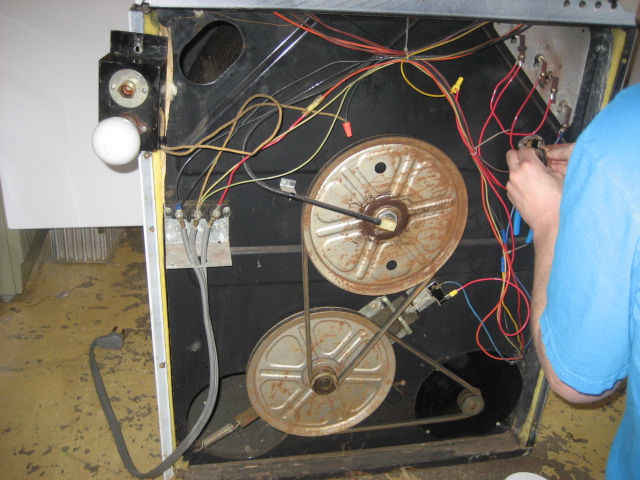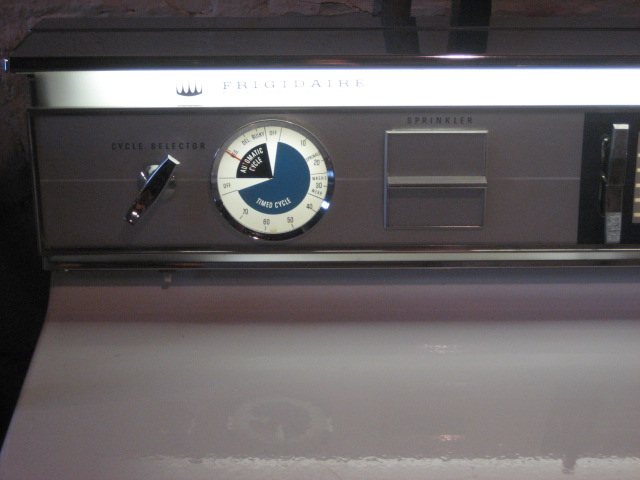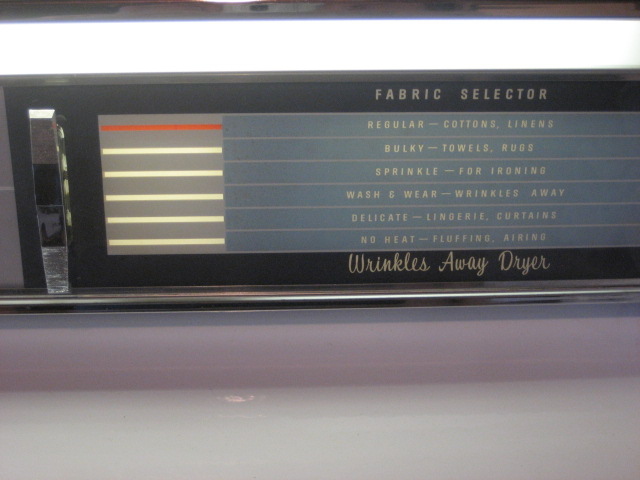|
Thread Number: 38681
1960 Filtrator back in service |
[Down to Last] |
Post# 573781 2/5/2012 at 19:52 (4,462 days old) by Kenmore71  (Minneapolis, MN) (Minneapolis, MN) |
||

Earlier this weekend I was visiting Swestoyz (Ben) down in Waterloo and we spent some time cleaning up and doing some rewiring work on a beautiful 1960 Frigidaire Custom Imperial Filtrator. Cosmetically it was in quite nice shape, there was just a bit of wiring work that needed to be reworked. Here it is with the back off and Ben is finishing up some wiring work.

| ||

|
Post# 573782 , Reply# 1 2/5/2012 at 19:52 (4,462 days old) by Kenmore71  (Minneapolis, MN) (Minneapolis, MN) |
||
 | ||
Post# 573784 , Reply# 2 2/5/2012 at 19:53 (4,462 days old) by Kenmore71  (Minneapolis, MN) (Minneapolis, MN) |
||
 | ||
Post# 573785 , Reply# 3 2/5/2012 at 19:54 (4,462 days old) by Kenmore71  (Minneapolis, MN) (Minneapolis, MN) |
||

Close-up of the timer dial.
1960 was either the first or second year of an automatic dryness control on a Filtrator. It was a thermostatic type control. The timer motor operates whenever the heater is "off". 
This post was last edited 02/05/2012 at 20:45 | ||
Post# 573786 , Reply# 4 2/5/2012 at 20:00 (4,462 days old) by Kenmore71  (Minneapolis, MN) (Minneapolis, MN) |
||

Close-up of the other side of the console.
This looks fancy, but all it really is a complicated looking thermostat control indicator. The buttons move the selector tape up and down WHILE it adjusts adjust the thermostat setting. The temps. that Tech-Talk give are as follows: Regular: 200 degrees Bulky: 187 degrees Sprinkle: 175 degrees Wash & Wear: 150 degrees Delicate: 125 degrees Air fluff: no heat Now, remember, that because of the way a filtrator works, temperatures can be much higher without fabric damage since clothes are essentially "steam-dried." 
This post was last edited 02/05/2012 at 20:46 | ||
Post# 573787 , Reply# 5 2/5/2012 at 20:01 (4,462 days old) by Kenmore71  (Minneapolis, MN) (Minneapolis, MN) |
||
 | ||
Post# 573807 , Reply# 6 2/5/2012 at 21:22 (4,462 days old) by combo52  (50 Year Repair Tech Beltsville,Md) (50 Year Repair Tech Beltsville,Md) |
||
1960 FRIGIDAIRE CUSTOM IMPERIAL DRYER Fun dryer Mark and Ben thanks for sharing your experiences with it. Tom and I have this Filterater and everyone from 1950 on that Frigidaire built. This is only the second year for auto dry, In fact very few manufactures had auto dry settings until about this time. In my experience using these dryers they dry fairly well if you have the temperature set at hi or close to it, at the lower temperatures they get very slow. These dryers operate at higher temperatures because they will not dry quickly at normal temperatures. And indeed in spite of drying in a steaming environment once the moisture is gone the clothing will reach 200 degrees+ and you can easily ruin delicate clothing in these dryers if not used carefully and properly.
Ben I will be interested to here how you like using this dryer.
| ||
Post# 573813 , Reply# 7 2/5/2012 at 21:38 (4,462 days old) by Kenmore71  (Minneapolis, MN) (Minneapolis, MN) |
||

I have been fascinated with Filtrator dryers since I first learned about them a few years ago. This was my first experience "inside" of one. They are a very curious appliance and, in certain applications, can be a very efficient appliance. I can really see an advantage to using these dryers in northern climates in the winter where the heat and small amount of moisture that is produced by the operation of these dryers STAYS in the house instead of being vented outside along with already heated household air.
I would have LOVED to have had one of these dryers to sit in front of as a young child in our drafty 1916 farm house during the 1970s energy crisis! At the same time, I can see how problematic one of these could be in an unairconditioned house in Houston in July. | ||
| Post# 573838 , Reply# 8 2/6/2012 at 01:34 (4,462 days old) by lebron (Minnesota) | ||
 | ||
Post# 573852 , Reply# 9 2/6/2012 at 07:05 (4,461 days old) by combo52  (50 Year Repair Tech Beltsville,Md) (50 Year Repair Tech Beltsville,Md) |
||
Condenser dryers Mark I too only use these in the colder months of the year, can you imagine using one of these when the central A/C is running. Interestingly when I compare just the electrical power use of a air-cooled condensing dryer [ I have compared 1950s and my 1962 Frigidaire CI dryer, and a 2000 Asko ] to just a regular 29" WP or KM electric dryer, the condenser models are not only far slower and dry far hotter but also use 25% more total power. I have never tested our old 1956 MT water condensing dryer for power consumption, I will have to do this sometime. | ||
| Post# 573971 , Reply# 12 2/7/2012 at 01:14 (4,461 days old) by qualin (Canada) | ||
|
I really love this design. The seperate "Control Dial" seems very futuristic looking to me, very googie! I'll admit I really like this style, with the seperate dial for the timer. Too bad that this kind of style went away by the 70's. | ||
| Post# 573975 , Reply# 13 2/7/2012 at 01:22 (4,461 days old) by AutoWasherFreak () | ||
|
That is a beautiful set of Frigidaires! | ||
Post# 574282 , Reply# 14 2/8/2012 at 06:42 (4,459 days old) by Launderess  (Quiet Please, There´s a Lady on Stage) (Quiet Please, There´s a Lady on Stage) |
||
According To My GM/Frigidaire Dryer Manual
There were several incarnations of Filtrator dryers that worked on 120v so am going to have to keep my eyes peeled. Think it would be kind of fun to have a larger drum than my vintage Whirlpool portable and about 300 more watts of heating power.
Ages ago remember one of those Euro combo front loading W/D units a friend had. IIRC that machine used water for condensing and managed a small load in a decent amount of time. Since they lived in an apartment building using all that water to "dry" laundry didn't phase her none. | ||
Post# 574374 , Reply# 15 2/8/2012 at 08:56 (4,459 days old) by combo52  (50 Year Repair Tech Beltsville,Md) (50 Year Repair Tech Beltsville,Md) |
||
120 volt Frigidaire Filterator dryer Tom and I rescued a TR-61 20+ years ago that I still have and use at times in the winter. It was exactly the same as the 240 volt TR-60 except it had one 1700 @ 120 volts instead of having two 2200 watt @ 240 volts. It is very slow but not as slow as trying to run the 240 V model on 120 as that would only give you 1100 watts of heat. These 120V models were made throughout the 1950s and they could be fairly easily converted to 240Vs by installing the 240V heaters, all the wiring was already in place and the same. | ||

 Comes to the Rescue!
Comes to the Rescue!